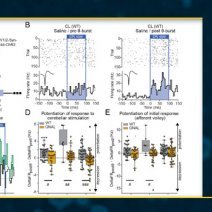Functional abnormalities in the cerebello-thalamic pathways in a mouse model of DYT25 dystonia.
Baba Aïssa Hind#, Sala Romain#, Georgescu Laura#, Frontera Jimena, Varani Andrés, Menardy Fabien, Pelosi Assunta, Hervé Denis, Léna Clément*, Popa Daniela*
Abstract
Dystonia is often associated with functional alterations in the cerebello-thalamic pathways, which have been proposed to contribute to the disorder by propagating pathological firing patterns to the forebrain. Here, we examined the function of the cerebello-thalamic pathways in a model of DYT25 dystonia. DYT25 (Gnal+/-) mice carry a heterozygous knockout mutation of the Gnal gene, which notably disrupts striatal function, and systemic or striatal administration of oxotremorine to these mice triggers dystonic symptoms. Our results reveal an increased cerebello-thalamic excitability in the presymptomatic state. Following the first dystonic episode, Gnal+/- mice in the asymptomatic state exhibit a further increase of the cerebello-thalamo-cortical excitability, which is maintained after θ-burst stimulations of the cerebellum. When administered in the symptomatic state induced by a cholinergic activation, these stimulations decreased the cerebello-thalamic excitability and reduced dystonic symptoms. In agreement with dystonia being a multiregional circuit disorder, our results suggest that the increased cerebello-thalamic excitability constitutes an early endophenotype, and that the cerebellum is a gateway for corrective therapies via the depression of cerebello-thalamic pathways.
Elife. 2022 Jun 14 ;11:e79135. doi:10.7554/eLife.79135.


